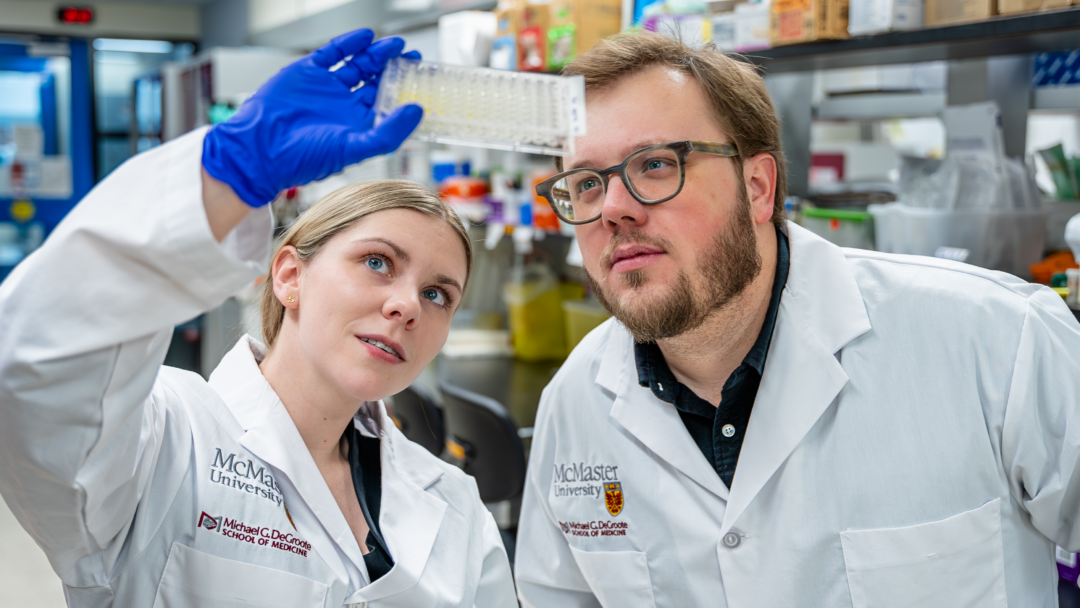A new cell that remembers allergies has been discovered by researchers from McMaster University and the Danish pharmaceutical company ALK-Abello A/S.
 McMaster University researchers Allyssa Phelps, left, and Josh Koenig, right, are part of a team that discovered a new cell that remembers allergies. Image Credit: Adam Ward
McMaster University researchers Allyssa Phelps, left, and Josh Koenig, right, are part of a team that discovered a new cell that remembers allergies. Image Credit: Adam Ward
The research was co-led by Peter Sejer Andersen, senior vice president and head of research at ALK, and Josh Koenig, assistant professor with McMaster’s Department of Medicine, published in Science Translational Medicine and discusses a novel cell a type-2 memory B cell (MBC2).
We’ve discovered a type of memory B cell that had unique characteristics and a unique gene signature that has not been described before. We found allergic people had this memory B cell against their allergen, but non-allergic people had very few, if any.”
Josh Koenig, Assistant Professor, Department of Medicine, McMaster University
B cells are a type of immune cell that makes antibodies. These cells help fight off infections but can also cause allergies.
Koenig says, “Let’s say you’re allergic to peanuts. Your immune system, because of MBC2, remembers that you’re allergic to peanuts, and when you encounter them again, it creates more of the antibodies that make you allergic.”
To find hard-to-find memory B cells, researchers synthesized tetramers, a kind of fluorescent molecule, from allergens like peanuts and birch pollen. Previously, Koenig and his group wrote a guide on how to find these elusive cells using tetramers.
Moreover, samples from ALK clinical trials were used in tablet sublingual immunotherapy, which enables the sequencing of a significant number of B cells that produce IgE. They were able to establish a direct link between MBC2 and IgE, the type of antibody that causes the allergic reaction, by utilizing state-of-the-art techniques like single-cell transcriptomics and deep sequencing of antibody gene repertoires on clinical trial samples. This gave the background information that was required to identify the MBC2 as the origin of the allergy.
Even though allergies are the most prevalent disease worldwide, it is still not fully understood how allergy occurs and evolves into a life-long condition. Finding the cells that hold IgE memory is a key step forward and a game-changer in our understanding of what causes allergy and how treatment, such as allergy immunotherapy, can modify the disease. We are very excited about this finding and grateful to the team at McMaster University for an excellent and productive collaboration.”
Peter Sejer Andersen, Senior Vice President and Head of Research, ALK
The discovery gives scientists and researchers a new target in treating allergies and could lead to new therapeutics.
The discovery really pinpoints two potential therapeutic approaches we might be able to take.”
Kelly Bruton, Co-lead Researcher and a PhD student, McMaster University
Bruton did Ph.D. alongside Koenig. Bruton is now a postdoctoral fellow at Stanford University.
Bruton says, “The first is targeting those MBC2s and eliminating them from an allergic person. The other option could involve changing their function and have them do something that’s not going to be ultimately harmful when the individual is exposed to the allergen.”
Though more research is necessary to fully comprehend the situation and eventually develop treatments, the identification of MBC2s gives individuals who suffer from food allergies fresh hope.
Koenig says, “These are the types of discoveries that you really need to make in order to develop the right therapeutics to block the right cells to stop the disease.”
Niels Peter Knudsen and Allyssa Phelps also shared leadership of the research. Koenig also mentions McMaster medical professor Manel Jordana as having a key role in the discovery.
Source:
Journal reference:
Koenig, E.F. J., et.al. (2024) Type 2–polarized memory B cells hold allergen-specific IgE memory. Science Translational Medicine. doi.org/10.1126/scitranslmed.adi0944